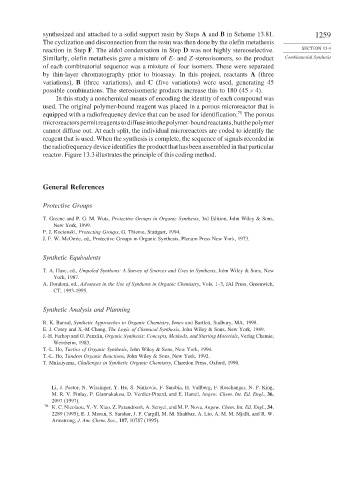Page 1283 - Advanced Organic Chemistry Part B - Reactions & Synthesis
P. 1283
synthesized and attached to a solid support resin by Steps A and B in Scheme 13.81. 1259
The cyclization and disconnection from the resin was then done by the olefin metathesis
reaction in Step F. The aldol condensation in Step D was not highly stereoselective. SECTION 13.4
Similarly, olefin metathesis gave a mixture of E- and Z-stereoisomers, so the product Combinatorial Synthesis
of each combinatorial sequence was a mixture of four isomers. These were separated
by thin-layer chromatography prior to bioassay. In this project, reactants A (three
variations), B (three variations), and C (five variations) were used, generating 45
possible combinations. The stereoisomeric products increase this to 180 45×4 .
In this study a nonchemical means of encoding the identity of each compound was
used. The original polymer-bound reagent was placed in a porous microreactor that is
70
equipped with a radiofrequency device that can be used for identification. The porous
microreactorspermitreagentstodiffuseintothepolymer-boundreactants,butthepolymer
cannot diffuse out. At each split, the individual microreactors are coded to identify the
reagent that is used. When the synthesis is complete, the sequence of signals recorded in
the radiofrequency device identifies the product that has been assembled in that particular
reactor. Figure 13.3 illustrates the principle of this coding method.
General References
Protective Groups
T. Greene and P. G. M. Wuts, Protective Groups in Organic Synthesis, 3rd Edition, John Wiley & Sons,
New York, 1999.
P. J. Kocienski, Protecting Groups, G. Thieme, Stuttgart, 1994.
J. F. W. McOmie, ed., Protective Groups in Organic Synthesis, Plenum Press New York, 1973.
Synthetic Equivalents
T. A. Hase, ed., Umpoled Synthons: A Survey of Sources and Uses in Synthesis, John Wiley & Sons, New
York, 1987.
A. Dondoni, ed., Advances in the Use of Synthons in Organic Chemistry, Vols. 1–3, JAI Press, Greenwich,
CT, 1993-1995.
Synthetic Analysis and Planning
R. K. Bansal, Synthetic Approaches to Organic Chemistry, Jones and Bartlett, Sudbury, MA, 1998.
E. J. Corey and X.-M Chang, The Logic of Chemical Synthesis, John Wiley & Sons, New York, 1989.
J.-H. Furhop and G. Penzlin, Organic Synthesis: Concepts, Methods, and Starting Materials, Verlag Chemie,
Weinheim, 1983.
T.-L. Ho, Tactics of Organic Synthesis, John Wiley & Sons, New York, 1994.
T.-L. Ho, Tandem Organic Reactions, John Wiley & Sons, New York, 1992.
T. Mukaiyama, Challenges in Synthetic Organic Chemistry, Claredon Press, Oxford, 1990.
Li, J. Pastor, N. Wissinger, Y. He, S. Ninkovic, F. Sarabia, H. Vallberg, F. Roschangar, N. P. King,
M. R. V. Finlay, P. Giannakakou, D. Verdier-Pinard, and E. Hamel, Angew. Chem. Int. Ed. Engl., 36,
2097 (1997).
70
K. C. Nicolaou, Y.-Y. Xiao, Z. Parandoosh, A. Senyei, and M. P. Nova, Angew. Chem. Int. Ed. Engl., 34,
2289 (1995); E. J. Moran, S. Sarshar, J. F. Cargill, M. M. Shahbaz, A. Lio, A. M. M. Mjalli, and R. W.
Armstrong, J. Am. Chem. Soc., 117, 10787 (1995).

